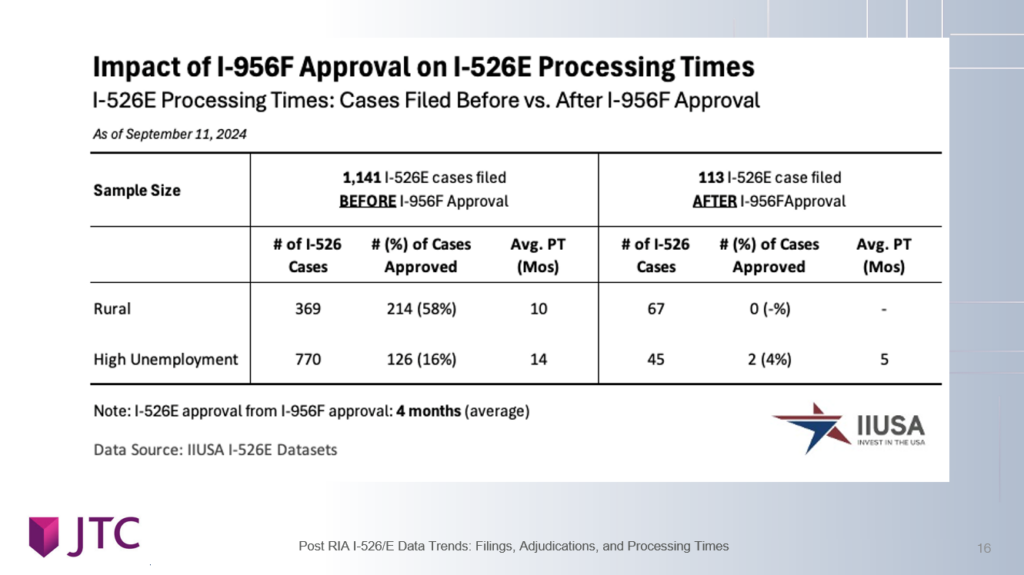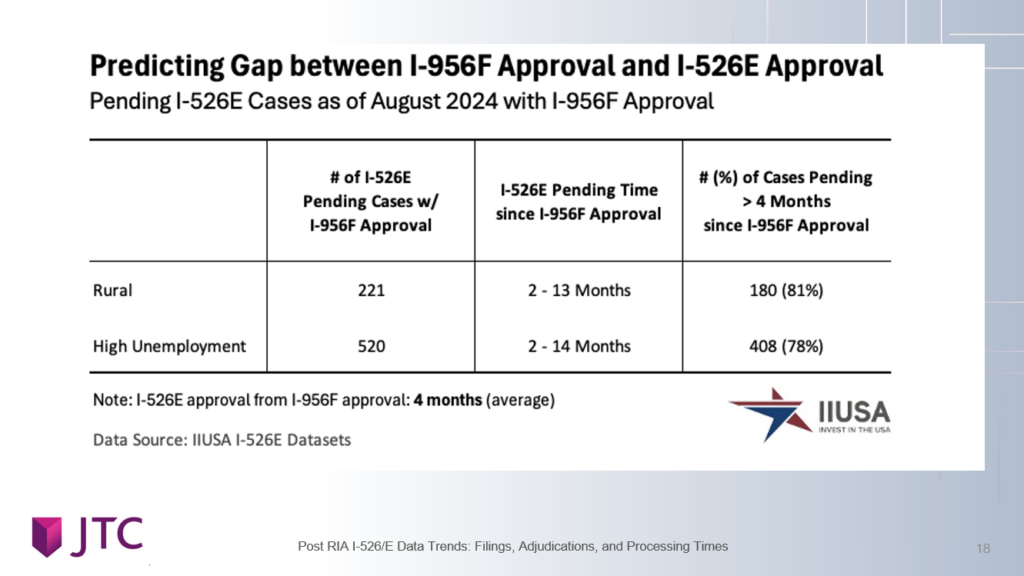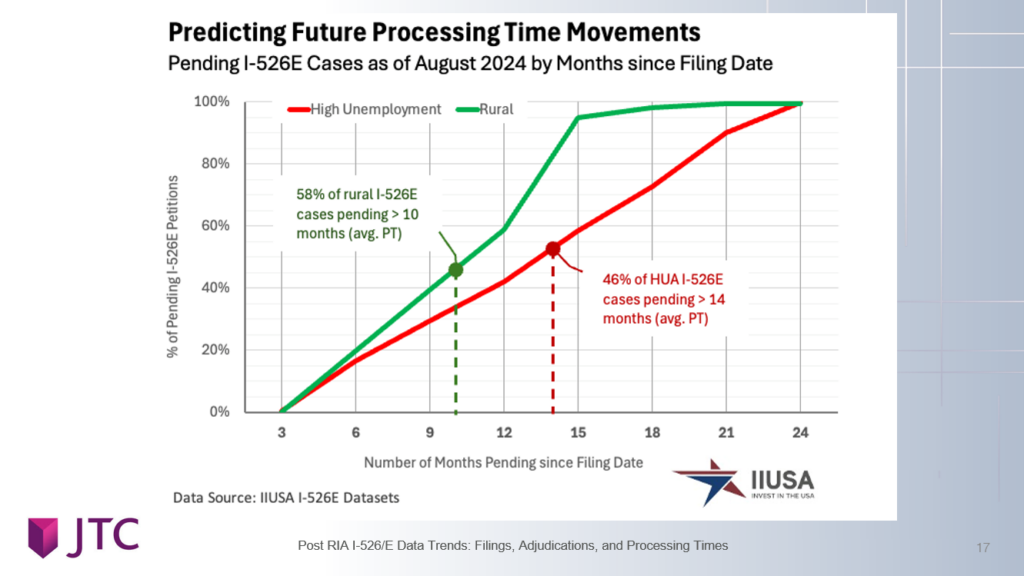Since the implementation of the EB-5 Reform and Integrity Act of 2022 (RIA), the I-526 and I-526E filing processes have changed significantly. However, one of the biggest challenges remains accessing reliable, real-time data from USCIS.
To bridge this gap, Invest in the USA (IIUSA), in collaboration with 11 regional centers and through the Freedom of Information Act (FOIA), collected and analyzed actual I-526E and I-956F processing times. The findings of their analysis were recently published in a comprehensive report.
In conjunction with the release of the report, IIUSA hosted a webinar with industry experts, including CanAm’s Chief Operating Officer, Christine Chen, to discuss the latest trends in case filings, adjudications, and processing times in the EB-5 program. As the EB-5 market evolves under the Reform and Integrity Act (RIA), it’s crucial to analyze how these changes are impacting the industry, especially for investors and project developers.
LEARN MORE: Post-RIA I-526/E Data Trends: EB-5 Webinar Recording Now Available
Impact of I-956F Approvals on I-526E Processing
The relationship between the I-956F (regional center project approval) and I-526E (individual investor petition) processing times has become a focal point of discussion within the EB-5 community. Understanding this correlation is essential, as the I-526E petition can only be adjudicated once the related I-956F has been approved. This interdependency has added a layer of complexity to the EB-5 process, particularly in determining how long it will take for an investor to receive their petition approval.

In the analysis conducted by IIUSA, the data on this relationship showed mixed results. Cases that were filed after the I-956F approval generally exhibited faster adjudication times. A small sample of such cases showed an average processing time of around five months for I-526E petitions filed after the I-956F was approved. However, the dataset for these cases is limited, so it is too early to make broad generalizations about whether filing post-I-956F approval guarantees faster processing.
On the other hand, for the bulk of the cases that were filed before the I-956F approval, processing times were longer, with many still pending. This backlog indicates that the timing of I-956F approvals is critical to speeding up the processing of I-526E petitions. This trend highlights the importance of investors and their legal advisors monitoring the status of the I-956F closely when making decisions about filing their I-526E petitions. It could be strategic to wait for the I-956F approval before submitting an I-526E petition to potentially reduce processing times.

The backlog of pending cases awaiting adjudication further complicates this issue, making it clear that the gap between I-956F and I-526E approvals is a significant factor in determining overall processing timeframes. It is anticipated that as more data becomes available, the industry will gain a clearer understanding of how to navigate this complex relationship more effectively.
Pending Cases and Future Projections
One of the more telling aspects of the data analysis is the number of pending I-526E cases, which sheds light on the potential trajectory of future processing times. As of the latest available data, approximately 58% of rural I-526E petitions had been pending for more than 10 months, while fewer than half of high-unemployment urban project petitions had been pending for more than 14 months. These figures are concerning, as they suggest that once these cases are adjudicated, the overall average processing times will likely increase.

The increasing backlog of pending cases raises questions about how processing times will evolve moving forward. While current processing times for approved petitions are relatively short—around 10 months for rural projects and 14 months for high-unemployment urban projects—there is a clear risk that these averages will lengthen as USCIS works through the backlog. This backlog is compounded by the limited number of adjudicators assigned to EB-5 cases, despite the increase in filing fees under the Reform and Integrity Act (RIA), which were intended to boost resources for the adjudication process.
For investors and regional centers, understanding the number of pending cases is crucial for managing expectations about processing times. Investors need to be aware that while their petitions may fall within current average timeframes, the reality is that future processing could be slower, especially as the number of pending cases grows. This is particularly true for rural projects, which, while prioritized under the RIA, are not immune to the broader delays affecting the EB-5 process.
Challenges and Litigation Risks with Delays
The growing backlog of I-526E petitions, particularly for those filed before the I-956F approval, poses significant challenges for investors and their representatives. With the average processing times expected to increase due to the sheer volume of pending cases, there is a rising risk of investor frustration and potential litigation against USCIS for processing delays.
One possible outcome of extended delays is an increase in writ of mandamus filings. A writ of mandamus is a legal action that compels a government agency to fulfill its duties—in this case, to adjudicate pending I-526E petitions promptly. This tool has been used successfully in the past when processing times for EB-5 petitions extended beyond reasonable expectations. The RIA, which includes specific timelines for processing, could provide a strong foundation for investors to pursue legal action if USCIS fails to meet the established targets.
In addition to the risk of litigation, the delays are likely to have broader implications for investor confidence in the EB-5 program. Lengthy processing times may discourage prospective investors from participating in the program, particularly when coupled with the significant financial commitments required for participation. Furthermore, with the EB-5 program being a competitive option among global residency-by-investment programs, prolonged delays could make the U.S. less attractive to international investors.
The increase in EB-5 filing fees, which jumped from $4,675 to $12,160 under the RIA, adds another layer of complexity. These higher fees were intended to provide USCIS with the necessary resources to meet the new processing timeframes outlined in the RIA. However, if delays persist despite these increased fees, it could trigger additional scrutiny of how USCIS is utilizing these resources and whether further reforms are necessary to streamline the process.
Conclusion
The I-526E petition processing landscape is shaped by multiple factors, including the timing of I-956F approvals, the growing backlog of pending cases, and the looming threat of litigation due to delays. As more data becomes available, regional centers, investors, and their legal advisors must stay vigilant in tracking processing trends to make informed decisions. With the potential for longer wait times and the possibility of legal action if delays continue, managing investor expectations will be critical in maintaining confidence in the EB-5 program.


